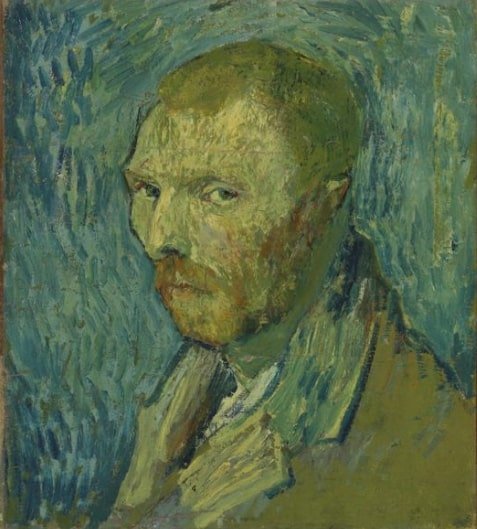Katherine J. Wu/Smithsonianmag.com
In the spring of 1889, Vincent van Gogh checked himself into the Saint-Paul-de-Mausole asylum, seeking treatment for a series of psychotic episodes that had driven him to poor health, strained his personal relationships and cost him at least part of his left ear.

Though confined to two cells with barred windows, the artist didn’t falter in his craft: During his year-long stay, van Gogh produced multiple paintings immortalizing his new surroundings. He captured the hospital’s interior and the vibrant olive trees he saw on his supervised walks; he painted rippling, golden-hued cornfields and the dazzling, star-studded night sky he glimpsed outside of his window.
Van Gogh also turned his artistic lens inward, portraying the dreary, listless expression he saw when he gazed into the mirror. The result was his August 1889 self-portrait, a gloomy, uncharacteristically drab oil painting depicting his suited torso and gaunt, unsmiling face, barely cloaked beneath his beard.
Though the painting has been in Norway’s national collection since 1910, its untextured style and arrestingly dreary color palette, dominated by greens and browns, began to seed doubts among experts in the 1970s. Now, after half a century of controversy, Amsterdam’s Van Gogh Museum has announced that the self-portrait is “unmistakably”
Read Full Article at SmithsonianMag.com

Carol graduated from Riverside White Cross School of Nursing in Columbus, Ohio and received her diploma as a registered nurse. She attended Bowling Green State University where she received a Bachelor of Arts Degree in History and Literature. She attended the University of Toledo, College of Nursing, and received a Master’s of Nursing Science Degree as an Educator.
She has traveled extensively, is a photographer, and writes on medical issues. Carol has three children RJ, Katherine, and Stephen – one daughter-in-law; Katie – two granddaughters; Isabella Marianna and Zoe Olivia – and one grandson, Alexander Paul. She also shares her life with her husband Gordon Duff, many cats, and two rescues.
ATTENTION READERS
We See The World From All Sides and Want YOU To Be Fully InformedIn fact, intentional disinformation is a disgraceful scourge in media today. So to assuage any possible errant incorrect information posted herein, we strongly encourage you to seek corroboration from other non-VT sources before forming an educated opinion.
About VT - Policies & Disclosures - Comment Policy




Here’s an interesting theory concerning Vincent’s condition:
“the painter was known to have suffered from tinnitus, which he described as ringing or roaring in the ears, as well as impaired hearing and intolerance of loud noises (classic Meniere’s symptoms)…
“For a century he was thought to have been epileptic and was well known as the crazy painter who cut off his own ear. In an effort to correct the record, Arenberg et al. (1990), a group of neuro-otologists, reviewed 796 of Van Gogh’s personal letters to family and friends written between 1884 and his suicide in 1890. Their analysis reveals a man who was constantly in control of his reason, but who suffered from severe and repeated attacks of disabling vertigo, not a seizure disorder. In their opinion, the clinical descriptions in his letters are those of a person suffering from Meniere’s disease, not epilepsy. The authors point out that Prosper Meniere’s 1861 description of his syndrome (an inner-ear disorder) was not well known when Van Gogh died and that it often was misdiagnosed as epilepsy well into the 20th century. Arenberg et al. concluded that it is highly probable that he suffered from Meniere’s”.
https://hearinghealthmatters.org/hearinginternational/2011/the-mysterious-case-of-vincent-van-goghs-pinna/
Comments are closed.